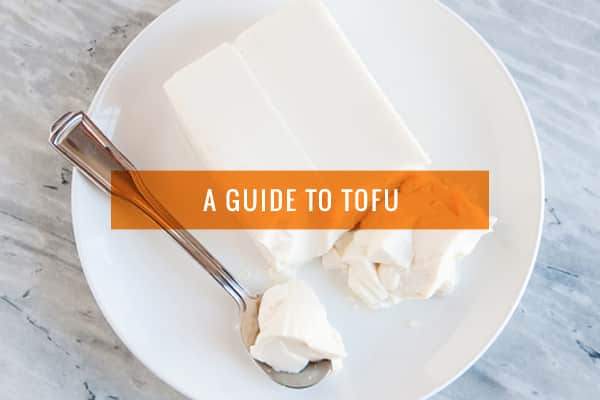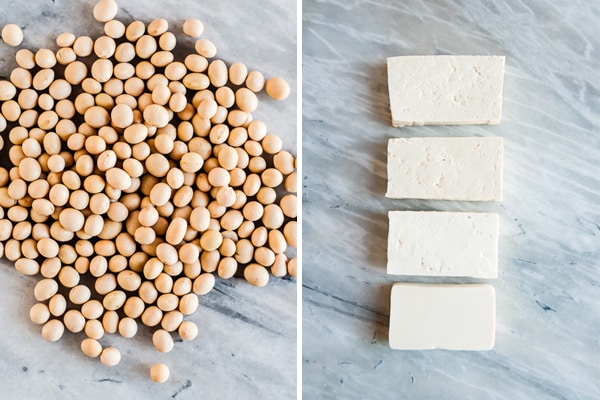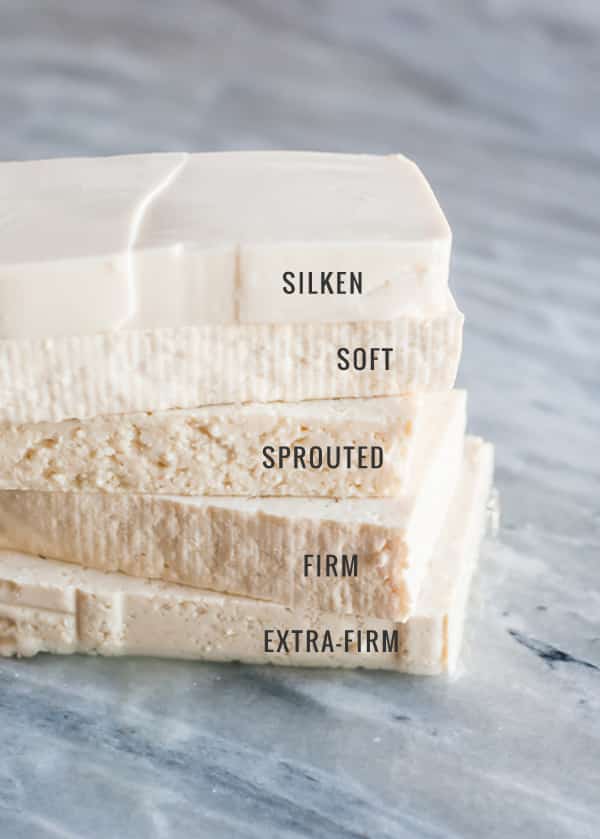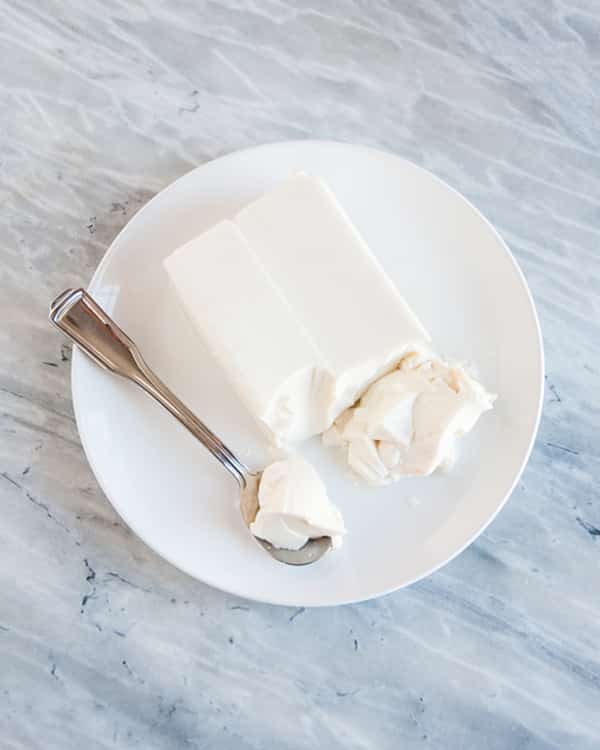 Photos by Lindsey Johnson
Photos by Lindsey Johnson
Tofu is a rather misunderstood ingredient in the culinary world. There are tofu lovers, and there are plenty of tofu haters. But what’s interesting about tofu, versus other foods that divide, is that many haters eventually make leap to lovers. Really! Don’t believe me? Go ask some of your most devoted tofu fans how they felt about it on first taste. For most, myself included, the key to loving your tofu is all in getting to know it – what it is, how to prepare it and how to eat it.
So let’s first talk a bit about what tofu is. At some point around my first tofu experience (you know, the one where I decided I didn’t like it), I was informed that tofu is soy curds. Yeah, not really the type of description that might entice one to fall in love with the stuff. But in essence, tofu is a lot like cheese, and cheese is easy to love.

To give you an idea of what I’m talking about, here’s a brief overview of how tofu is made:
- Saturate some soybeans with water.
- Blend until smooth.
- Strain out the soybean pulp – what you end up with is soymilk.
- Add a coagulant – i.e., curdling agent, hence “soy curds.” This could be something as simple as lemon juice. The more coagulant you use, the more separation you get, and in turn, the firmer your tofu.
- Strain out the liquid and keep the solids.
- Press solids to remove excess liquid and achieve desired firmness. Again, more pressing removes more water to yield a firmer 'fu.
If you’ve ever made ricotta cheese or paneer, these steps probably sound pretty familiar. After step 3, which results in soy milk, it’s essentially the same process as cheese-making, and just as easy to execute. If you’d like to give this a try, we’ve even got a tofu-making tutorial!
More important than the basic process and ingredients that go into making tofu, are the different types of tofu. Choosing the right type and knowing what to do with it is key. That first bad tofu experience of mine that I mentioned above? It involved (on poor advice) putting extra firm tofu into a strawberry milkshake. Don’t do that.
Silken or Japanese Tofu
As the name implies, silken tofu has a silky-smooth texture that’s less, uh...curdy than other varieties. This is because silken tofu has the highest moisture content. Unlike other varieties, silken tofu isn’t pressed. When you open a package of silken tofu, you’ll find a semi-solid, somewhat gelatinous, custardy material that fills the entire container and needs to be scooped out. Because of the high moisture content, it’s the most delicate and least sturdy of your tofu types. In fact, if you tried to pick up a chunk of silken tofu with a fork, it would probably fall to pieces, so it’s not the type of tofu that you’d want to pan-fry or bake. Instead, silken tofu works much better when blended to a creamy desserts and dressings. Silken tofu is the type you’d want to blend into a smoothie.
If you dine on tofu at a Japanese restaurant, there’s a good chance you’ll get this type of tofu. Because it doesn’t stand up to common tofu cooking methods, it’s usually served as uncooked cubes in sauce or sometimes deep fried.
Soft Tofu
You’ll sometimes hear the “soft tofu” used interchangeably with “silken tofu,” but when you’re out shopping you’ll want to pay attention to these labels, as they mean different things. Soft tofu undergoes some pressing to remove water – just not a whole lot. Unlike silken tofu, soft tofu is sold as a block and is packed in water. Even though it’s soft and has a high moisture content, soft tofu doesn’t have the creamy-smooth texture of silken tofu. Something of a hybrid between silken and firmer varieties in that respect, soft tofu is probably the variety that is called for least often in recipes, though it can work as a substitute for silken tofu where a thicker texture is desired. A whole lot of blending will yield a smoother texture that’s still a bit denser than silken varieties, which I actually sometimes prefer.
Firm and Extra-Firm Tofu
These are the types of tofu you’re most likely to eat for dinner and are probably the most widely used types. These varieties have the lowest moisture contents, with extra-firm having less mositure than firm. This is because they undergo the most pressing and separation (meaning they are prepared using more coagulant). You can eliminate even more water by pressing your tofu before cooking - you can follow our tutorial, or buy a tofu press, which we highly recommend if you use tofu often! It's less messier, more convenient, and gives better results. Less water is a good thing when you’re looking for a crispy outside texture. You’ll even hear tofu enthusiasts sometimes discuss their favorite hacks for removing water beyond the initial pressing. Pre-baking, microwaving and soaking in salt water have all been claimed to yield that perfect crispy outer surface. I generally just plan ahead and let my tofu press for an extended period when I’m going for crispy perfection. Pan frying, baking, and scrambling are all great uses for firm and extra-firm tofu.
Firm and extra-firm tofu can go even a step further. Tofu with names like "super-firm" or "extra-extra firm" are popping up on store shelves. These varieties seem to work best when pan-fried, as they're a bit too dense to crumble well. One advantage to using these is that the water content is so low to begin with that usually no additional pressing is needed. Just pat dry with a paper towel and you’re good to go.
Specialty Tofu Types
Some more exotic tofu varieties are popping up on store shelves and across the web as of late. Some are made with soybeans, in accordance with the strict definition of "tofu," while others use some other type of curd.
Black tofu, which is actually purple in color, is one variety you might have seen in the refrigerator case of a health food or specialty store. This is the same as regular old tofu, just made with black soybeans, whereas conventional tofu is made from yellow soybeans. It’s a bit smoother and higher in protein than yellow soybean tofu, but otherwise very similar and can be used in the same ways. Same goes for sprouted tofu—it’s the same as regular old tofu, but made with sprouted soybeans.
Non-soybean "tofu" varieties include chickpea and almond. These products are produced using the tofu-making steps I’ve described above, but with stuff other than soybeans.
Tips for Tofu Newbies
If you’re trying tofu for the first time, you might not want to prepare it yourself. Head out to a good vegetarian or Asian restaurant, as both are likely to have lots of tasty tofu options. This will give you an idea of what tofu should taste like, so you have something to shoot for when you give it a try on your own. There are also lots of packaged tofu options that require little or no preparation. Scope out the tofu section of your local health food store and you’ll likely find varieties that are cooked and seasoned for you. These are great for throwing on sandwiches and into salads and should help to give you an idea of what flavors you like in your tofu.
When you do decide it’s time to venture out and make your first home-cooked tofu dinner, follow a trusted recipe (we've got tons!) and follow it closely. I know this seems like common sense, but seasoned cooks in particular are often guilty of assuming they’ve got things figured out and winging it. As an ingredient, tofu is in a class by itself, so best to start by playing it safe. I wouldn’t want you to miss out on all the tofu love that’s out there to be had.
This post was originally published on September 14, 2014.




Inna says
That was very informative, as I am a newbie in a Vegan world. Thank you!
Alissa says
Awesome! Glad you found it helpful!
Millie | Add A Little says
I love silken tofu with some freshly grated ginger and soy sauce - yum!
Alissa says
I get something like that at some of my favorite Japanese places. Love it!
Ordinary Blogger (Rivki Locker) says
What a great overview of tofu. I almost always stick to what I know - the firm or extra firm variety. I'll have to try some of these others.
Alissa says
Thank you! I definitely get the most use out of firm and extra firm as well - but you really can do a lot with the other types too!
Klara says
This is probably the most helpful blog post I've ever read! Thank you 🙂
Alissa says
You're welcome and I'm so glad to hear it! Thank you so much Klara!
Audrina @ Mindfully Audrina says
Definitely going to use lemon juice with my tofu now! Thanks for the helpful tips, I will use tofu more now 🙂
Alissa says
Excellent! Happy to help! 🙂
anon says
I'm anemic and I'm trying to eat less meat. Plus I'm diabetic so I would need something low in carbs, which makes it hard for me not to eat meat. Does anyone have any idea how tofu stacks up in the high in protein/low in carbs area?a
Alissa says
Tofu is considered a good source of protein as far as plant-based foods go. Looking at the nutrition label for a package of extra-firm tofu right now, and it lists 9 grams of protein and 3 grams of carbs per serving. I hope that helps!
Jessica @ Jessica in the Kitchen says
Thanks for this post Alissa. I truly think people who don't like tofu just haven't found the right one for them or the right prep methods. I personally prefer firm and extra firm tofu - used it in a stir fry just the other day!
Alissa says
I'm so with you on all of that! Learning how to prep your tofu is definitely key....and I definitely love me some extra firm tofu in a good stir fry!!
holly waterfall says
I love cooking with tofu. but it's funny that you say to go to restaurants to try tofu out before trying it at home. personally, I am not usually a fan of the way restaurants prepare tofu and love the way I do. I have always experienced a mushy/tasteless tofu in restaurants where I make a tough/chewy textured tofu with a ton of flavor. I guess you've had much better experiences than I have!
Alissa says
I'm sure it depends on the restaurant. I had the best luck when I lived in the city and there were lots of Asian places around that made their own tofu and cooked it up all crispy - now that was some good tofu! 🙂
Nicole @ Foodie Loves Fitness says
Great post! I definitely think that tofu is all about how it's prepared. I've had times when I don't like it all, and other times when I've loved it. One thing I haven't done with tofu is put it in smoothies - for some reason that idea scares me just a little! Haha.
Alissa says
Thanks Nicole! I can see why putting it into a smoothie might seem a little weird. Try silken - the texture is totally different from the other types and I'll bet you'd never know it was even in there. 🙂
Leiah says
I feel the same way about soy milk and tell people all the time -- if you didn't like it the first time, try it again! I always encourage people to try different brands of soy milk, different flavors, or different veggie milks altogether (almond, coconut, hemp, etc). And I agree with tofu -- I didn't used to really like it but now I have figured out my favorite tricks for making it tasty 🙂
Alissa says
I totally agree! It took me a while to enjoy soy milk as well. There's definitely a big difference between brands and with different types on non-dairy milk.
Akshita Singh says
Great article.Bookmarked it for future reference 🙂 I am just a beginner to tofu and was looking for such resource. Thankyou.
Alissa says
Thank you! I know working with tofu can be a bit daunting at first, so I'm glad you found this helpful!
Natalie Tamara says
Some great tips here - I agree that it's impossible to know if you like tofu or not the first time because it can be so different 🙂
Another trick I like to do with tofu is to freeze it first and it becomes a totally new ingredient!
Alissa says
Thanks Natalie! I love to freeze tofu as well - it takes on such a great crumbly texture that I love for stuff like tacos and chili!
Mychal says
I just bought a big box of "extra firm silken tofu". I haven't yet opened it up to see just what that might mean - have you heard of this? Silken isn't usually firm, and firm isn't usually silken. I'm not sure how I'll use it.
Alissa says
It should have the smooth texture of regular silken tofu, with a bit more density. You can use it in most recipes that call for silken tofu. If you use it in a blended recipe, like a dessert, you'll end up with something a little thicker - which can be a good thing! If it ends up too thick you can usually get away with adding a little soy or almond milk. You can also use it in some Japanese dishes that call for cubed, uncooked tofu in sauce. Good luck! 🙂
Ruth says
Thank you for this blog. I am just getting into learning to cook with tofu and this explained a lot. Now I know what to use in what recipe. 😉
Alissa says
You're welcome! So glad this post was helpful and I hope you get to enjoy preparing some new tofu dishes soon!
Ruth says
I'm partial to stir fry and using the grill/smoker. I found a recipe for teriyaki tofu "steaks" that I have been wanting to try out in the smoker. I'm going to try it out with Wildwood brand extra firm sprouted tofu I found at my local Safeway (Von's in So Cal).
Alana says
You explained this so well, I actually understand the different types of tofu now! So easy, thank you!
Alissa says
Mission accomplished! Glad this helped - thanks Alana!
Phyllis says
The first time I ever tried tofu was a cheesecake recipe on a package of extra firm tofu. (This was back in the late 70's/early 80's when there wasn't as much variety as now).
Epic fail doesn't begin to describe it! Lol!
Nice to know that silken tofu would be the way to go if I were to ever try it again.
Alissa says
Haha! Sounds a lot like my milkshake experience. I've made cheesecake with silken tofu, and I can confirm that if you work with a good recipe, the result is awesome. 🙂
Wendi Shier says
I was always told tofu had to be cooked…is this wrong info? I guess it must be to use it in smoothies
Alissa says
You might be thinking of tempeh. I've heard that uncooked tempeh can cause digestive upset due to the bacteria that's used in the fermentation process. Uncooked tofu is just fine - in fact, even "uncooked" tofu is technically cooked, as it's heated at the time the coagulant is added to facilitate separation.
Wendi Shier says
No, it was tofu. It was just wrong, haha. Thanks for setting me on the right track. We've been looking for a healthy source of protein for our smoothies…i think I'm going to give the silken a a try.
Thanks again
Sarah | Well and Full says
This is so helpful, thank you!! 😀